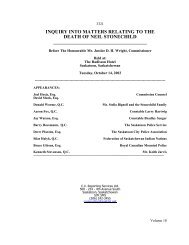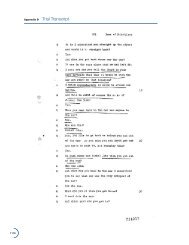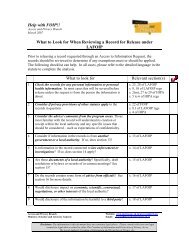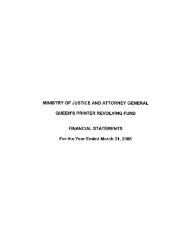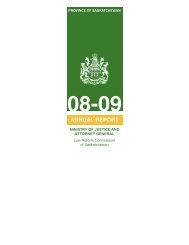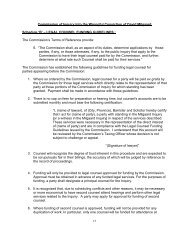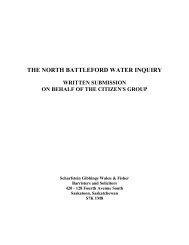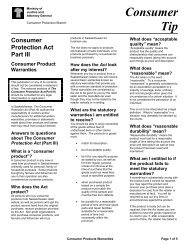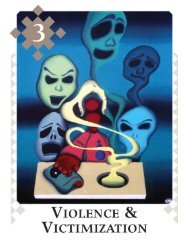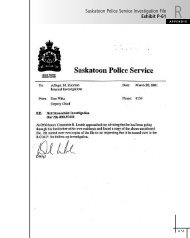Appendix K Memorandum of Law - s. 9(2) of the Canada Evidence Act
Appendix K Memorandum of Law - s. 9(2) of the Canada Evidence Act
Appendix K Memorandum of Law - s. 9(2) of the Canada Evidence Act
You also want an ePaper? Increase the reach of your titles
YUMPU automatically turns print PDFs into web optimized ePapers that Google loves.
<strong>Appendix</strong> K <strong>Memorandum</strong> <strong>of</strong> <strong>Law</strong><br />
From <strong>the</strong> foregoing cases and a consideration <strong>of</strong> what is necessary in <strong>the</strong> proper administration <strong>of</strong><br />
justice we are satisfied that <strong>the</strong>re is no rule <strong>of</strong> law nor any established practice which prohibits a<br />
trial Judge from considering a prior inconsistent statement (verbal or written) as part <strong>of</strong> <strong>the</strong> material<br />
to establish <strong>the</strong> fact that a witness is hostile. In some cases it may in itself be sufficient to establish<br />
that fact. It is for <strong>the</strong> trial Judge say whe<strong>the</strong>r he is so satisfied. If a prior inconsistent statement is to<br />
be used for this purpose, <strong>the</strong> inquiry should be on <strong>the</strong> voir dire, as was done in this case, or in such a<br />
manner that <strong>the</strong> jury does not know <strong>of</strong> <strong>the</strong> contents <strong>of</strong> <strong>the</strong> statement until <strong>the</strong> trial Judge has ruled on<br />
<strong>the</strong> question <strong>of</strong> adversity <strong>of</strong> <strong>the</strong> witness and has announced he is prepared to admit <strong>the</strong> statement as<br />
evidence under sec. 32, as was done in Russell v. Dalton (supra). We are <strong>the</strong>refore <strong>of</strong> <strong>the</strong> opinion that <strong>the</strong><br />
learned trial judge was not in error in <strong>the</strong> course which he pursued in this case and that his determination that <strong>the</strong><br />
witness Hunter was a hostile witness cannot be called into question. 33<br />
One hundred and four years later, <strong>the</strong> majority in <strong>the</strong> Ontario Court <strong>of</strong> Appeal in Wawanesa (OCA) rejected<br />
<strong>the</strong> decision in Greenough v. Eccles. In particular, <strong>the</strong> majority rejected <strong>the</strong> meaning <strong>of</strong> ‘adverse’ and <strong>the</strong><br />
procedure for proving adversity laid down in that case. It held instead that a party producing a witness<br />
was entitled to rely on a prior inconsistent statement to prove ‘adversity’ under <strong>the</strong> Ontario counterpart to<br />
s. 9(1) <strong>of</strong> <strong>the</strong> CEA. 34 It is worth noting that all three judges in Wawanesa (OCA) considered Hannigan and<br />
Hunter in <strong>the</strong>ir decisions. 35<br />
Chief Justice Porter stated as follows at page 187 <strong>of</strong> Wawanesa (OCA):<br />
The first case in which <strong>the</strong> meaning <strong>of</strong> “adverse” was considered was Greenough v. Eccles, supra, where<br />
“adverse” was held to mean “hostile”. …<br />
I find it difficult to appreciate this reasoning. If it had been intended that a witness must be shown to be hostile<br />
in mind before <strong>the</strong> statement could be admitted, <strong>the</strong> statute could have said so. The word “adverse” is a more<br />
comprehensive expression than “hostile”. It includes <strong>the</strong> concept <strong>of</strong> hostility <strong>of</strong> mind, but also includes what may<br />
be merely opposed in interest or unfavourable in <strong>the</strong> sense <strong>of</strong> opposite in position. 36<br />
He went on to state:<br />
In cases where application is made to introduce a prior inconsistent statement under <strong>the</strong> <strong>Act</strong>, <strong>the</strong> Judge should<br />
[sic] to determine whe<strong>the</strong>r a witness is adverse, consider <strong>the</strong> testimony <strong>of</strong> <strong>the</strong> witness, and <strong>the</strong> statement, and<br />
satisfy himself upon any relevant material presented to him that <strong>the</strong> witness made <strong>the</strong> statement. He should<br />
consider <strong>the</strong> relative importance <strong>of</strong> <strong>the</strong> statement, and whe<strong>the</strong>r it is substantially inconsistent. I think <strong>the</strong> Judge is<br />
entitled to consider all <strong>the</strong> surrounding circumstances that may assist him in forming his opinion as to whe<strong>the</strong>r <strong>the</strong><br />
witness is adverse. It would be proper and <strong>the</strong> safer course, if such an enquiry becomes necessary, to conduct<br />
it in <strong>the</strong> absence <strong>of</strong> <strong>the</strong> jury, if <strong>the</strong> case is being tried by a jury. If after due enquiry <strong>the</strong> Judge is satisfied that <strong>the</strong><br />
witness is adverse, he may consider whe<strong>the</strong>r under all <strong>the</strong> circumstances, and bearing in mind <strong>the</strong> possible<br />
dangers <strong>of</strong> admitting such a statement, <strong>the</strong> ends <strong>of</strong> justice would be best attained by admitting it. The section<br />
does not contemplate <strong>the</strong> indiscriminate admission <strong>of</strong> statements <strong>of</strong> this kind. If he exercises this discretion in<br />
favour <strong>of</strong> giving leave, he should in <strong>the</strong> presence <strong>of</strong> <strong>the</strong> jury, direct that <strong>the</strong> circumstances <strong>of</strong> <strong>the</strong> making <strong>of</strong> <strong>the</strong><br />
statement be put to <strong>the</strong> witness and that he be asked whe<strong>the</strong>r he made <strong>the</strong> statement. Then, in <strong>the</strong> presence<br />
<strong>of</strong> <strong>the</strong> jury, he should allow <strong>the</strong> statement to be proved but he should instruct <strong>the</strong> jury that <strong>the</strong> prior statement<br />
is not evidence <strong>of</strong> <strong>the</strong> facts contained <strong>the</strong>rein, but is for <strong>the</strong> purpose <strong>of</strong> showing that <strong>the</strong> sworn testimony given<br />
at <strong>the</strong> trial could not be regarded as <strong>of</strong> importance: R. v. Duckworth, 26 C.C.C. at p. 351, 37 O.L.R. at p. 234,<br />
per Masten, J., and R. v. Harris, supra. It is for <strong>the</strong> jury, upon all <strong>the</strong> evidence before <strong>the</strong>m, to decide whe<strong>the</strong>r<br />
33 Hunter, supra note 30 at pp. 32 to 34. Section 32 <strong>of</strong> <strong>the</strong> Victorian <strong>Evidence</strong> <strong>Act</strong> 1928 is equivalent to section 9(1) <strong>of</strong><br />
<strong>the</strong> CEA: see Justice MacKay’s judgment in Wawanesa (OCA), supra note 21 at p. 220.<br />
34 Alan Bryant submits that <strong>the</strong> line <strong>of</strong> reasoning and test applied in <strong>the</strong> majority’s ruling in Wawanesa (OCA) is <strong>the</strong><br />
preferable interpretation <strong>of</strong> s. 9(1) <strong>of</strong> <strong>the</strong> CEA and its provincial and commonwealth counterparts: The Statutory Rule,<br />
supra note 11 at p. 123.<br />
35 Per Justice Porter at p. 189; per Justice MacKay at pp. 218 and 219; and per Justice Roach at pp. 202 to 204.<br />
Wawanesa (OCA), supra note 21.<br />
36 Wawanesa (OCA), supra note 21 at p. 187.<br />
2584



